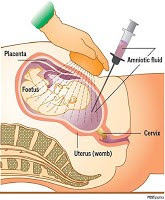Genetic trisomies
Autosomal
Down's syndrome
Definition
Down syndrome is a birth defect of chromosomal origin which causes mental retardation caused by the presence of a dose of extra chromosomal region that causes down phenotype (21q22).
Down syndrome is a birth defect of chromosomal origin which causes mental retardation caused by the presence of a dose of extra chromosomal region that causes down phenotype (21q22).
Genetic
aspects
There
are over 50 clinical signs of Down syndrome, but it is rare to
find all or even most of them in one person.
Some
common features include:
·
Weak muscle tone
·
slanted eyes
(upward sloping) with folds of skin on the inside corners (called epicanthic
folds)
·
Hypermobility
(excessive ability to extend the joints)
·
Wide and short
hands with a single line in the palm of one or both hands
·
Broad feet with
short fingers
·
Flattened nasal
bridge
·
Ears short, low
·
Short neck
·
Small head
·
Small oral cavity
·
Cries short, sharp
in childhood
Individuals
with Down syndrome are usually smaller than their peers without disabilities,
and their physical and intellectual development is slower.
Besides
having a distinct physical appearance, children with Down syndrome frequently
have specific health problems.
Reduced
resistance to infection makes these children more prone to respiratory
problems. Vision problems such as squint and have farsightedness or
nearsightedness are more likely in individuals with Down syndrome, as are the
loss of mild to moderate hearing and speech difficulties. Children with Down
syndrome may have a tendency to become obese as they grow older. Besides having
negative social implications, this weight gain threatens the health and
longevity of these individuals.
Associated
factors
·
Inbreeding: This has been
reported by several authors as not to cause mitotic disjunction. Individual
characteristics of parents can also cause a higher incidence of Down syndrome.
·
Maternal
age:
One of the earliest epidemiological characteristics observed is the increased
incidence of Down syndrome in older mothers and this is so primarily from a
threshold age is around 35 years.
·
Paternal age:
Recent studies using more sophisticated statistical techniques have
demonstrated a positive relationship between the disease and age of the father
from a threshold age of 45 years.
Epidemiology
The
frequency of congenital malformations in newborns is 3-4%, the DS is on average
1/800 births (Teratology 2000). Representing 5% of spontaneous abortions and
80% of conceptions with this condition are aborted.
In
Mexico, there is not epidemiological studies to determine the incidence of this
entity.
Diagnosis
Regardless
of the age at which the diagnosis of Down syndrome is made, once established
it, you must start the affected patient care.
Preimplantation
diagnosis
It
is a procedure particularly indicated in those carrier couples of chromosomal
rearrangements that determine an increased risk of children with phenotypic
alterations than the general population, patients with increased maternal age
of 35 years and infertility or a history of abortions or products of conception
with recurrence aneuploidy, who wish to avoid facing a pregnancy loss by these
conditions. The study is conducted in one or two blastomeres at the 8-cell
stage (3rd day after conception) using the technique of FISH (fluorescence in
situ hybridization).
Prenatal
diagnosis
Prenatal
diagnosis studies carried out at present for the detection of SD are
biochemical screening, ultrasound and chromosomal analysis of fetal cells.
These studies are performed on both the first and second trimester of
pregnancy.
Neonatal
diagnosis
Infants
with Down syndrome usually are children born at term, with 2500 g average
weight, described many signs of this syndrome, but the most prominent are:.
Congenital anomalies, development of malignancies, including leukemia and
various problems of health.
Age
management and monitoring
There
is no treatment to correct or reverse trisomy 21. The management is of the
consequences of this condition such as: hypothyroidism, infections, leukemia,
hypogonadism, endocrine disorders, etc., but not for chromosomal abnormalities.
For
individuals with Down syndrome, as for everyone else, progress from childhood
to adulthood is complex, not only for themselves but also for their families
and communities. These individuals may have different medical complications
depending on their age and need special attention as each of these stages.
The
surgical management of defects, control heart disease, respiratory or systemic
infections and early learning programs, physical medicine and language tracks,
are the most common options. Well, if required various drug therapies, for
example in the presence of thyroid dysfunction, seizures or psychiatric
disorders occur.
At
the moment the use of growth hormone therapy, cell or stimulating brain for
this condition is not accepted and is controversial the use of alternative
therapies supra pharmacological vitamins, minerals, amino acids and hormones
doses, as well as plastic surgery purposes aesthetic. As part of management
support, family counseling and genetic counseling it is included.
Epidemiological
surveillance
The
basic objectives of the search and surveillance of Down syndrome are:
·
knowing its
frequency - prevalence
·
Analyze
causality
·
Assess the
needs of health services and programs direct to the same preventive approach.
·
Work on preventive
aspects
All
birth defects, including Down syndrome, will gradually join the National
Epidemiological Surveillance System of the Ministry of Health.
Bibliography:
AURORA APARICIO MANRIQUE. (S/f). Mutations.
05/10/15, de biology 2 website: http://ies.rosachacel.colmenarviejo.educa.madrid.org/aurora.pdf
Jose s. ramil. (S/f). Mutations. 12/10/15, de ciencias
Sitio web: http://www.tirsoferrol.org/ciencias/pdf/a10_mutacion.pdf
Paola Cerruti Mainardi.
(2006). Orphanet Journal of Rare Diseases. BioMed Central, 33, 1-9.
Enrique Gómez Galán. (S /
F). Turner syndrome. 23.10.15, Spanish Association of Pediatrics Website: http://www.spao.es/documentos/biblioteca/entrada-biblioteca-fichero-60.pdf
Health Secretary. (2007). National Center for
Gender Equity and Reproductive Health. 30 / October / 2015, of Children's
Rehabilitation Center Telethon, the Group of Birth Studies AC, John Langdon
down Foundation, AC Website: http://www.salud.gob.mx/unidades/cdi/documentos/Sindrome_Down_lin_2007.pdf













No hay comentarios.:
Publicar un comentario